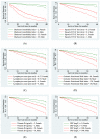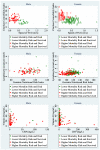Identification of Mortality Risks in the Advancement of Old Age: Application of Proportional Hazard Models Based on the Stepwise Variable Selection and the Bayesian Model Averaging Approach
- PMID: 33801694
- PMCID: PMC8066062
- DOI: 10.3390/nu13041098
Identification of Mortality Risks in the Advancement of Old Age: Application of Proportional Hazard Models Based on the Stepwise Variable Selection and the Bayesian Model Averaging Approach
Abstract
Identifying factors that affect mortality requires a robust statistical approach. This study's objective is to assess an optimal set of variables that are independently associated with the mortality risk of 433 older comorbid adults that have been discharged from the geriatric ward. We used both the stepwise backward variable selection and the iterative Bayesian model averaging (BMA) approaches to the Cox proportional hazards models. Potential predictors of the mortality rate were based on a broad range of clinical data; functional and laboratory tests, including geriatric nutritional risk index (GNRI); lymphocyte count; vitamin D, and the age-weighted Charlson comorbidity index. The results of the multivariable analysis identified seven explanatory variables that are independently associated with the length of survival. The mortality rate was higher in males than in females; it increased with the comorbidity level and C-reactive proteins plasma level but was negatively affected by a person's mobility, GNRI and lymphocyte count, as well as the vitamin D plasma level.
Keywords: Bayesian model averaging; Charlson Comorbidity Index; GNRI; TUG; geriatrics; lymphocytes; survival; vitamin D.
Conflict of interest statement
The authors declare no conflict of interest. The funders had no role in the design of the study; in the collection, analyses, or interpretation of data; in the writing of the manuscript; and in the decision to publish the results.
Figures




References
-
- Mladovsky P., Allin S., Masseria C., Hernández-Quevedo C., McDaid D., Mossialos E. Health in European Union: Trends and analysis. European Observatory on Health Systems and Policies. European Observatory on Health Systems and Policies; Copenhagen, Denmark: 2009. (Observatory Studies Series no. 19).
-
- Puzianowska-Kuznicka M., Kuryłowicz A., Walkiewicz D., Borkowska J., Owczarz M., Olszanecka-Glinianowicz M., Wieczorowska-Tobis K., Skalska A., Szybalska A., Mossakowska M. Obesity Paradox in Caucasian Seniors: Results of the PolSenior Study. J. Nutr. Health Aging. 2019;23:796–804. doi: 10.1007/s12603-019-1257-z. - DOI - PMC - PubMed
-
- De Ruijter W., Westendorp R.G.J., Assendelft W.J.J., den Elzen W.P.J., de Craen A.J.M., Cessie S., Jacobijn Gussekloo J. Use of Framingham risk score and new biomarkers to predict cardiovascular mortality in older people: Population based observational cohort study. BMJ. 2009;338:a3083. doi: 10.1136/bmj.a3083. - DOI - PMC - PubMed
MeSH terms
Grants and funding
LinkOut - more resources
Full Text Sources
Other Literature Sources

